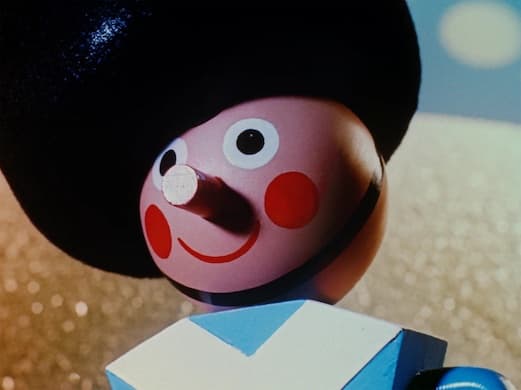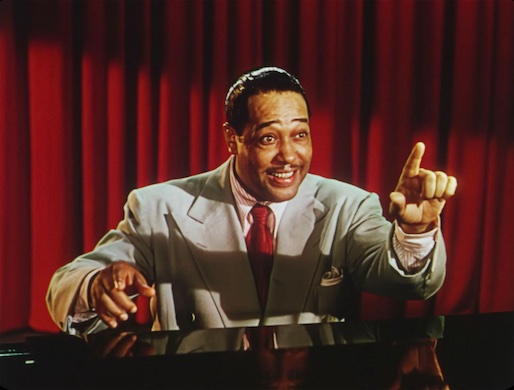Don’t Be Turned Off by the Name ‘Puppetoons’: This Series Swings
Nearly 90 years after George Pal pioneered the technique, the films are stunning: explosions of movement, color, and music, all depicted in wooden figures that seem to move magically across the screen.

‘The Puppetoon Movie, Vol. Three’
Puppetoon Productions
The only problem with George Pal’s “Puppetoons” is the name. When we hear the word puppet, we are inclined to first think of Jim Henson’s hand puppet creations. Yet the Puppetoons — the subject of an ongoing series of restored Blu-ray editions, of which the latest has recently been released — don’t actually involve puppets.
The original American title for the films, as imposed on them by their distributor, Paramount Pictures, was “Madcap Models,” and, assuming that the name doesn’t make you think of Heidi Klum, it may be closer to the point than “Puppetoons.”
The term “puppet animation” invokes something more like Art Clokey’s “Gumby” franchise, which utilizes what we euphemistically call “stop motion” animation. That is to say, the process involves figures that actually move in microscopic increments, one frame at a time — we just don’t see the hands of the animators moving them.
Contrastingly, the Puppetoons work more like conventional drawn animation, only with hand-carved three-dimensional figures. “No one in America had been able to produce short subjects in the medium of dimensional animation until George brought his technique over and started the Puppetoons,” a legendary animation auteur, Ray Harryhausen, explains in Arnold Leibovit’s 1985 documentary, “The Fantasy Film Worlds of George Pal.”
Harryhausen describes Pal’s technique as one of “replacement,” or “substitution.” Just as it took 24 drawings a second for Mickey Mouse to move or speak, Pal’s characters, such Tubby the Tuba or his African American hero, Jasper, took 24 separate carvings per frame to perform their actions.
Even today, nearly 90 years after Pal pioneered the technique, the films are stunning: explosions of movement, color, and music, all depicted in wooden figures that seem to move magically across the screen. The Puppetoons are especially powerful in the restored editions that Mr. Leibovit has spent the last 40 years perfecting, resulting in the three Blu-ray releases that he collectively calls “The Puppetoon Movie.”
Pal (1908-80) was born in Hungary, and spent the first part of his career in pre-war Europe. He was infatuated with American culture, especially jazz and African American folklore. A number of both his earlier European advertising films and later Hollywood short subjects feature prominent big bands of the swing era.
The third volume of “The Puppetoon Movie” series features several excellent examples of these. “Rhapsody in Wood” (1947) extends bandleader Woody Herman’s habit of riffing on his name. Born Woodrow Charles Herman, one of his first hits was the blues “Woodchopper’s Ball,” and “Rhapsody in Wood” has Herman, appearing first in live action, telling tale tales of his lumberjack grandfather, and how he encountered a magical tree that he carved into a clarinet.
Ralph Burns’s original work, “Rhapsody in Wood,” begins somewhat classically with an unaccompanied clarinet cadenza. It then flies into a modern jazz-style riff number in which the leader’s clarinet interacts with his entire orchestra, which had already been informally rechristened “The Thundering Herd.”

Also from 1947, “Date with Duke” represented Duke Ellington’s only appearance in a theatrical cartoon. Even though animation has traditionally been largely regarded as a medium for entertaining children, Ellington does not talk down to his audience here; rather, he offers some of his most sophisticated music.
This comes in the form of what was the latest extended work by Ellington and his longtime musical partner, Billy Strayhorn, “The Perfume Suite.” We hear excerpts from three movements, as an on-screen Ellington conducts an ensemble of animated perfume bottles (one of whom is voiced by a “child impersonator” actor, Walter Tetley). “Balcony Serenade” is warm and romantic, with elegant, creamy sounding saxophones; “Strange Feeling” is just the opposite, as a mischievous imp appears and summarily declares himself immune to the charm of the Duke’s music.
“Dancers in Love” puts the naysayer in his place; this piano-centric trio piece would become the most successful and most reprised section of the suite. A great modern jazz and salsa pianist, Hilton Ruiz, saw this cartoon as a child and later told me that this was what motivated him to want to make music: “My first inspiration.” As he elaborated to Francis Davis, “these animated characters came out of perfume bottles, and started doing cartwheels and tumblesaults across the keyboard. I knew then and there that I wanted to play the piano.”
“The Puppetoon Movie, Vol. Three” also includes other musical shorts, such as “Bravo Mr. Strauss” (1943), “Jasper’s Music Lesson” (1943), and “Hotlip Jasper” (1944), which features classical trumpet virtuoso Rafael Mendez playing Rimsky-Korsakov’s “Flight of the Bumble Bee.”
“Rhythm in the Ranks” (1941) has animated toy soldiers marching in syncopated formation to Raymond Scott’s “The Toy Trumpet.” There are also three cel animation shorts, produced in Holland, with soundtracks by a world-renowned British bandleader, Jack Hylton, and two early adaptations of children’s books by Dr. Seuss.
After the end of the short subject series in 1948, Pal went on to a legendary career as Hollywood’s most distinguished creator of fantasy and science fiction classics, like “Destination Moon” (1950), “War of the Worlds” (1953), and “The Time Machine” (1960), all of which were profound influences on latter day auteurs like George Lucas and Steven Spielberg. Yet “The Puppetoons,” the the producer’s son, Dave Pal, says, “are my father’s greatest work.” As he says in “The Fantasy Film Worlds of George Pal,” “they occupy a place of greatness in the history of animation.”
On Saturday, October 21, Mr. Friedwald is presenting a program of Puppetoons as part of the Jazz at Lincoln Center / Swing University film series “Jazz and Animation.” Mr. Leibovit is joining remotely as a special guest. The session will be live-streamed. For information, click here.

